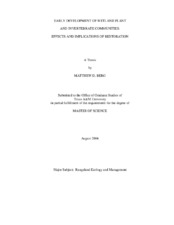| dc.description.abstract | Loss of wetland habitats across the nation is staggering and continues, especially
in urbanizing areas. Thus, wetland restoration has become a priority. However, questions
remain regarding system function and biotic communities. We studied a constructed
floodplain wetland complex near Dallas, Texas. We sought to improve understanding of
wetland ecosystem development under the influence of different approaches to wetland
restoration in an urbanizing landscape. In the wetland complex, 10 constructed sloughs,
approximately 70m by 15m, were designated for this study. Our experiment monitored
the establishment of aquatic plant and invertebrate communities under different
experimental conditions. In 5 sloughs, 5 native perennial hydrophyte species were
transplanted in blocks in each slough, with the remaining 5 sloughs unplanted. Portions
of each slough were caged to determine the effects of protective caging. Using 1m2
caged and neighboring uncaged areas as quadrats, we sampled vegetation and the
invertebrate community over two years to determine the effects of restoration treatmentsSlough planting did not result in statistically different levels of plant cover.
However, invertebrate abundance was greater in planted sloughs, and plant composition
was different, comprised more of perennial species in planted sloughs than in unplanted
sloughs. Caging did not have an effect on plant or invertebrate communities. However,
changes due to time resulted in significant increases in plant cover and invertebrate
abundance and shifts in community composition. Four of 5 transplanted species were
emergent growth forms. Emergent cover and the remaining species, Potamogeton
nodosus, a floating-leafed plant, accounted for invertebrate community variation.
Transplanted emergent species did not fare well, though other emergent species did
colonize the site, along with widespread coverage by submerged Najas guadalupensis.
Potamogeton spread rapidly, colonizing unplanted sloughs, and this will likely affect
community development across the site. Plant and invertebrate richness values were low,
likely due to hydrological extremes and the short period of time since construction.
Water level fluctuations resulted in plant communities dominated by obligate wetland
plants, though drought stress took a toll on survival of plants and invertebrates in late
summer. Community development and system function were dependent mostly upon
time and hydrology.
on the communities. | en |


